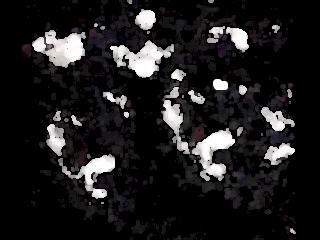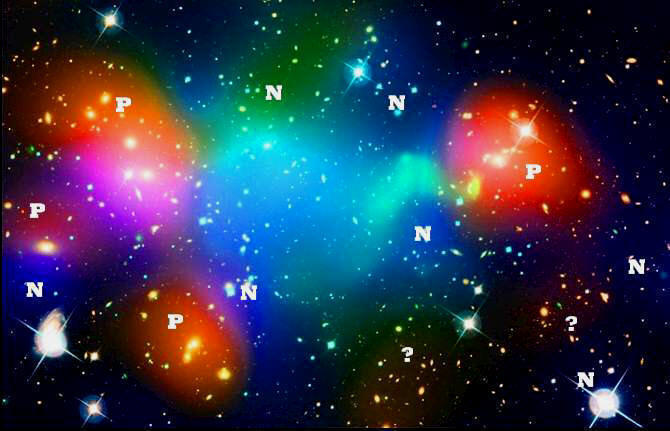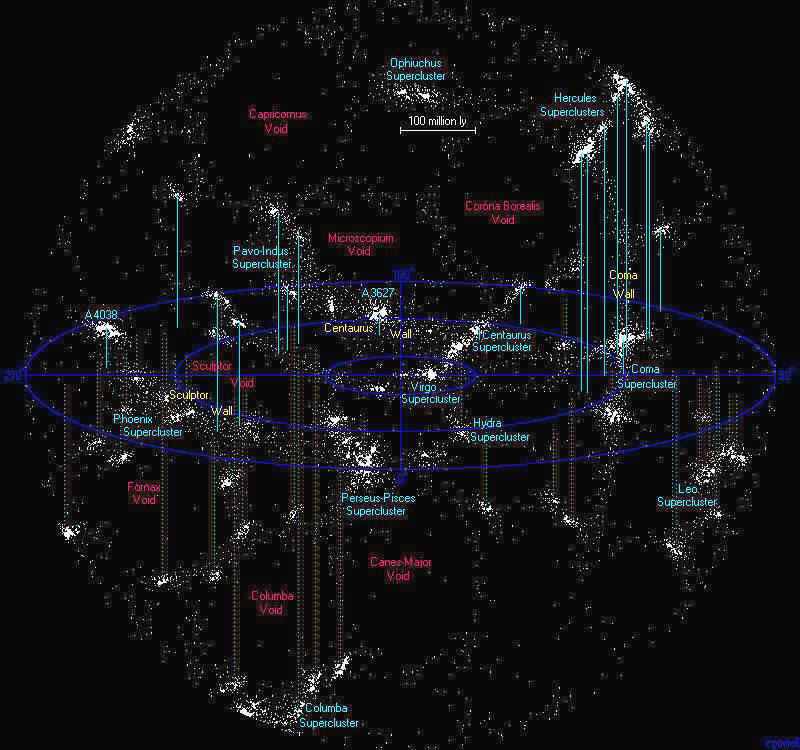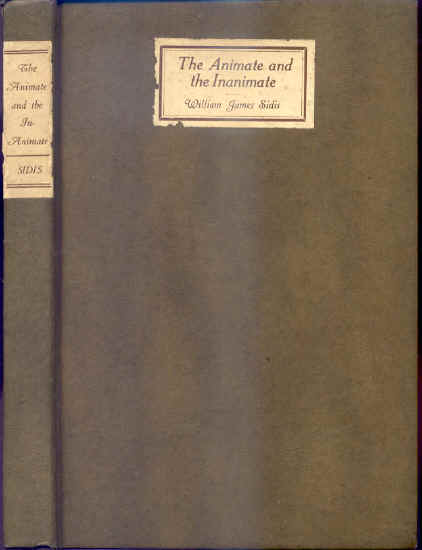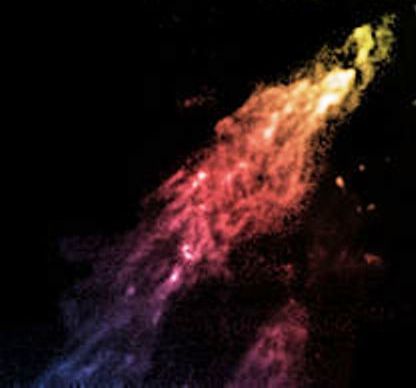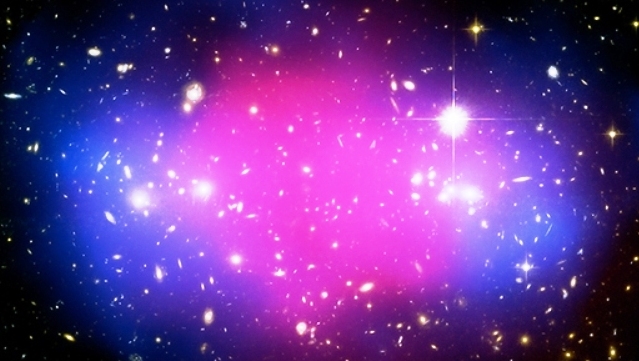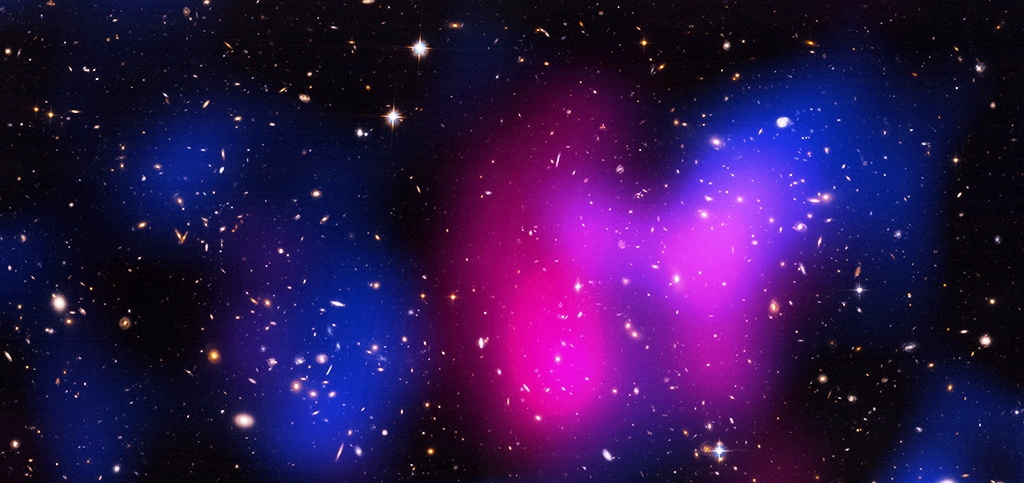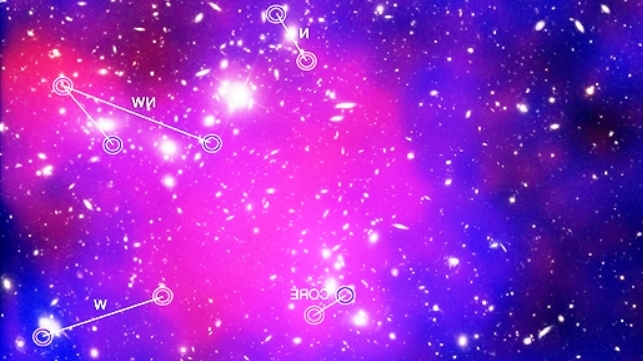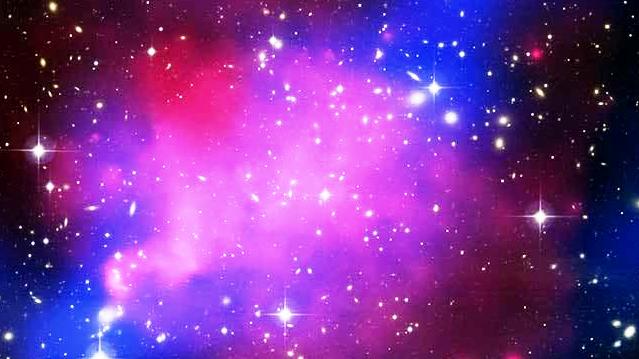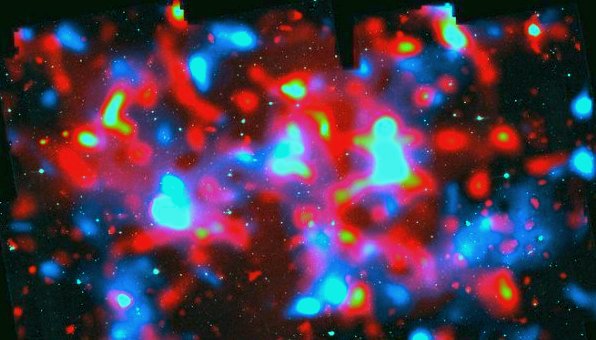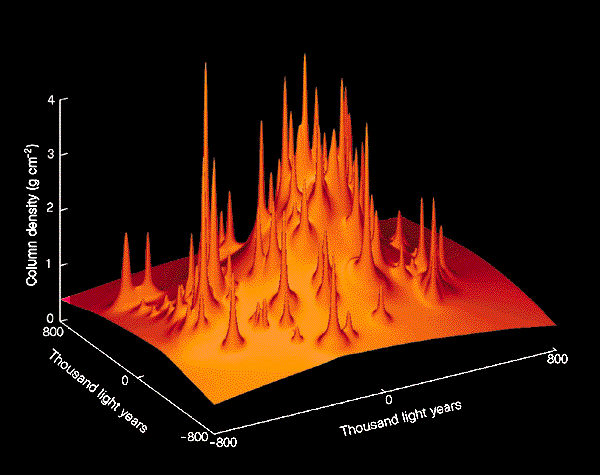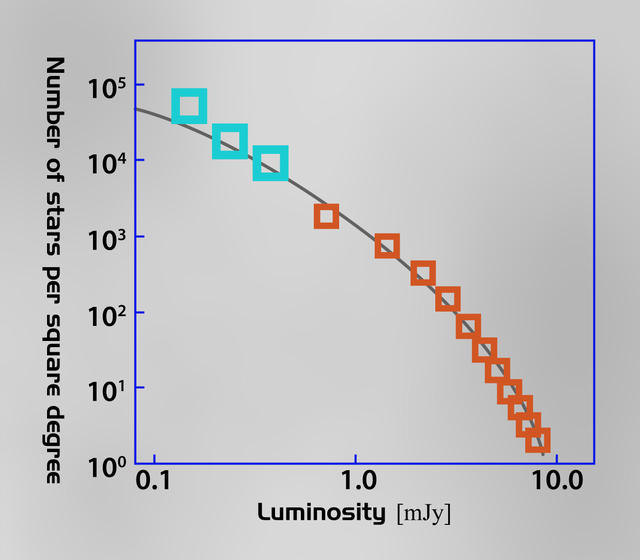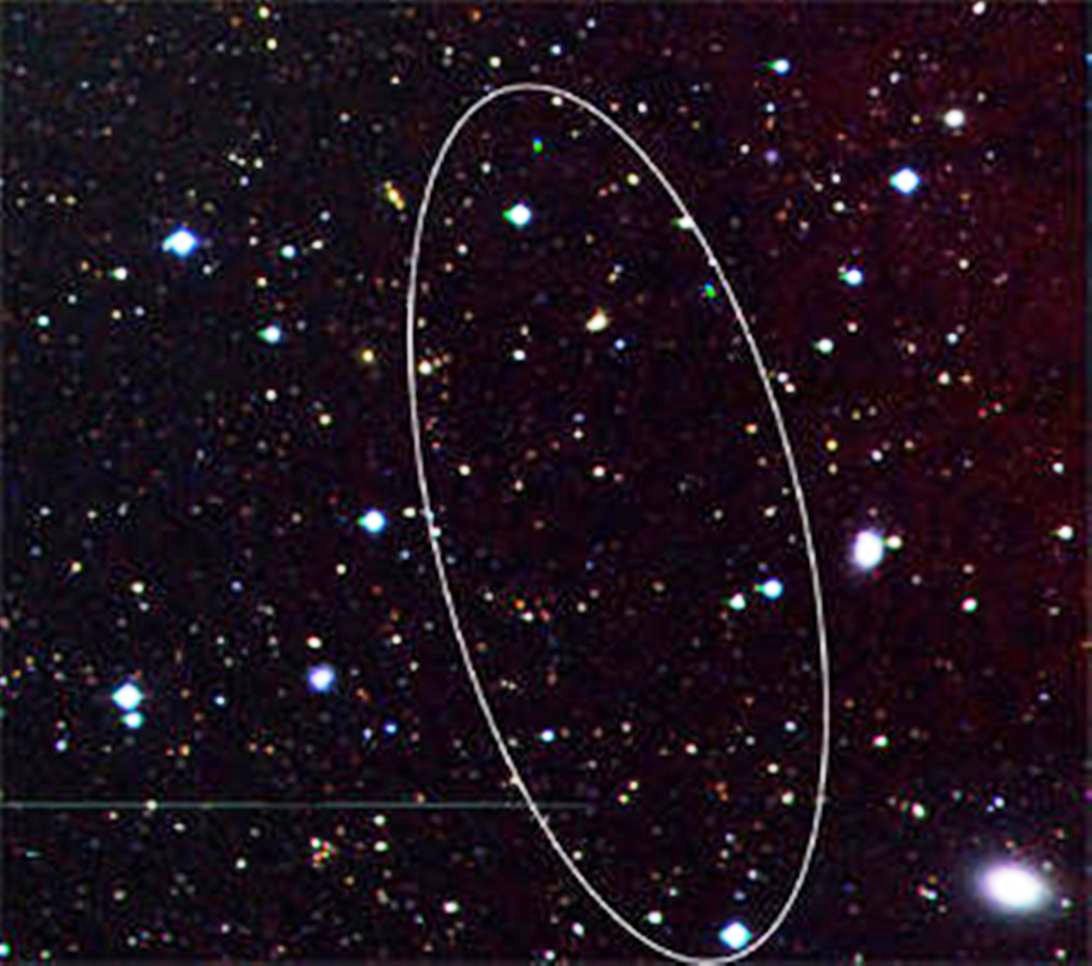SIDIS IRREGULAR 3-D CHECKERBOARD? "The shape of the cluster observed by the Subaru Telescope indicates the presence of a huge 3D web of invisible dark matter. The team found that their young monstrous galaxies seemed to be located right at the intersection of the dark matter filaments. This dark matter filamentary structure is thought to be a progenitor of large scale structures in the Universe." http://phys.org/news/2015-12-alma-monstrous-baby-galaxies-cradled.html#jCp
---------------------- SIDIS IRREGULAR 3-D CHECKERBOARD? DARK MATTER (BLUE) SURROUNDING NORMAL MATTER (GRAY) AND VICE VERSA —"... largest sample of the distribution of dark matter ever obtained. It demonstrates how normal matter - including stars, galaxies and gas - is built inside an underlying scaffolding of dark matter." http://www.esa.int/spaceinimages/Images/2007/01/ Comparison_of_normal_matter_and_dark_matter_s_large_scale_structure ---------------------- SIDIS IRREGULAR 3-D CHECKERBOARD? (In this inverted-color version of the original map, red is dark matter, blue is normal matter.) "The luminous matter that we can see is housed within the dark matter structures that we cannot see, and this dark matter forms a cosmic web of filaments, knots, and voids. The new data show large filaments of dark matter where visible galaxies and galaxy clusters lie and cosmic voids where very few galaxies reside." http://www.fnal.gov/pub/presspass/press_releases/2013/DES-20130903.html ---------------------- SIDIS IRREGULAR 3-D CHECKERBOARD? DARK MATTER (BLUE) SURROUNDING NORMAL MATTER (RED) AND VICE VERSA—This image is intended to represent the "first tremors of the Big Bang," but it illustrates the Sidis Model. In this and many of the images in MORE DATA, the blue areas represent the negative, dark-matter sections which surround the positive, ordinary-matter sections (red). In this particular diagram we see each type surrounding the other as in the Sidis Irregular 3-D Checkerboard model. ----------------------
SEE OUTLINE AND ANIMATIONS BELOW OF THE
-RELATED NEWS-
COSMIC VOIDS NOT EMPTY —CONSIST OF DARK MATTER AND DIM STRUCTURES—16APR2014—"Researchers at the University of Pennsylvania have measured the "weight" of these cosmic voids and filaments for the first time, showing the former are not as empty as they look. ... Dark matter and other dim structures permeate all the way to the center of the voids."http://www.upenn.edu/pennnews/news/cosmologists-penn-weigh-cosmic-filaments-and-voids ---------------------
KECK OBSERVATORY TEAM REPORTS DISCOVERY OF DARK MATTER WITH FILAMENT STRUCTURE—MAY BE EVIDENCE THAT DARK MATTER CONSISTS OF DARK STARS—15OCT2012—" ... a team of astronomers has uncovered the presence of a filament of dark matter extending from the core of the cluster. The location of the dark matter is revealed in a map of the mass in the cluster and surrounding region, shown here in blue. The filament visibly extends out and to the left of the cluster core.
THIS ANIMATION DESERVES AN AWARD—"Using additional observations from ground-based telescopes, the team was able to map the filament’s structure in three dimensions, the first time this has ever been done. The filament was discovered to extend back from the cluster core, meaning we are looking along it. ... The significant amount of dark matter in this cluster, shown in light blue, may be also similar to the Hercules–Corona Borealis Great Wall."
http://www.keckobservatory.org/recent/entry/astronomers_map_dark_matter_filament
---------------------
SUN EMITTING AXIONS? http://www.ras.org.uk/news-and-press/2524-curious-signal-hints-at-dark-matter
W. J. SIDIS MODEL OF THE UNIVERSE
SIDIS THREE-DIMENSIONAL CHECKERBOARD? Sky in our black and white version of the above Hubble Telescope composite photo shows normal matter (WHITE) surrounding dark matter (GRAY).
OPTICAL IMAGE OF NORMAL MATTER SURROUNDING DARK MATTER:
"The center of the Boötes void ... ."—keithwaynebrown.com --------------------- "DARK MATTER 'JACKET' SURROUNDS GALAXY— ... appears to be encased in a shell of dark matter, ... it appears the object is massive enough to be a galaxy itself." http://www.newscientist.com/article/dn13179-giant-gas-cloud-to-crash-into-our-galaxy.html
RED WHITE AND BLUE IMAGES SHOWING DARK MATTER (BLUE) AS HOT
HOT DARK MATTER?—"Data from NASA's Chandra X-ray Observatory are colored red, showing gas with temperatures of millions of degrees. In blue is a map showing the total mass concentration (mostly dark matter) ... ." http://chandra.harvard.edu/photo/2011/a2744/ ---------------------
HOT DARK MATTER?— " ... galaxies in the cluster make up less than 5 percent of its mass. The gas (around 20 percent) is so hot that it shines only in X-rays (colored red in this image). The distribution of invisible dark matter (making up around 75 percent of the cluster’s mass) is colored here in blue."http://www.nasa.gov/mission_pages/hubble/science/pandora-cluster.html --------------------- HOT DARK MATTER?—"In this composite image, the hot gas observed with Chandra is colored red, and the galaxies in the optical image from Hubble appear as mostly white and yellow. The location of the majority of the matter in the cluster (dominated by dark matter) is colored blue. When the red and the blue regions overlap, the result is purple as seen in the image." http://chandra.harvard.edu/photo/2012/musketball/ ---------------------
HOT DARK MATTER?—"... hot gas as detected by Chandra is colored red ... starlight from the individual galaxies (yellow and orange) ... most of the matter in the cluster (blue) is dominated by dark matter." http://chandra.harvard.edu/photo/2007/a520/ ---------------------
HOT DARK MATTER?—"Hot gas is shown in an image from NASA's Chandra X-ray Observatory, and galaxies are shown in an optical image from NASA's Hubble Space Telescope. The hot gas is color-coded to show temperature, where the coolest gas is reddish purple, the hottest gas is blue, and the temperatures in between are purple." http://hubblesite.org/newscenter/archive/releases/2009/17/image/a/ ---------------------
"... ordinary matter (shown in pink) and dark matter (highlighted in blue)." http://chandra.harvard.edu/photo/2008/macs/ --------------------- "This composite shows three different components of the Hubble COSMOS survey: The normal matter (in red) determined mainly by the European Space Agency’s XMM/Newton telescope, the dark matter (in blue) and the stars and galaxies (in grey) observed in visible light with Hubble." http://www.esa.int/spaceinimages/Images/2007/01/Hubble_COSMOS_survey
(Top) "Artist’s impression of the Milky Way and its dark matter halo (shown in blue, but in reality invisible). Credit: ESO/L. Calçada" http://phys.org/news/2014-10-dark-thought-scientists.html#jCp
--------------------- RING OF DARK MATTER IN 3-D CHECKERBOARD PATTERN AROUND GALAXY CLUSTER—"Dark matter in diffuse blue." http://apod.nasa.gov/apod/ap070516.html ---------------------
" ... the otherwise invisible dark matter in blue, and the positions of the cluster galaxies in yellow." http://apod.nasa.gov/apod/ap030814.html---------------------
"Clusters of galaxies like this one, MCS J0416.1-2403 located in the constellation of Eridanus, have long been theorized to be bound by cosmological dark matter." http://www.forbes.com/sites/brucedorminey/2014/12/20/new-doubt-about-dark-matter/
- -RELATED DATA-
IMAGES OF HEAT MAXIMA AND MINIMA IN A DARK GALAXY
HOT DARK MATTER? MAXIMUM AND MINIMUM CONCENTRATIONS OF ENERGY IN A DARKSTAR GALAXY——"The simulated distribution of dark matter in a Milky Way-like galaxy for standard, non-interacting dark matter ... The colours represent the density of dark matter, with red indicating high-density and blue indicating low-density."
HOT DARK MATTER? MAXIMUM AND MINIMUM CONCENTRATIONS OF ENERGY IN A DARKSTAR GALAXY—"Brightness (blue-to-violet-to-red-to-yellow) corresponds to increasing concentration of dark matter. The bright central region corresponds roughly to the Milky Way’s luminous matter of gas and stars, and the bright clumps indicate dark-matter satellites orbiting our Milky Way galaxy which are known as 'substructure'."
HOT DARK MATTER? MAXIMUM AND MINIMUM CONCENTRATIONS OF ENERGY IN A DARKSTAR GALAXY—"Diffuse, hot gas with a temperature of nearly 50 million degrees permeates the space between the galaxies. The gas emits X-rays, seen as blue in the image taken with the Chandra X-ray Observatory in November 2003. The X-ray portion of the image shows enormous holes or cavities in the gas, each roughly 640,000 light-years in diameter — nearly seven times the diameter of the Milky Way. The cavities are filled with charged particles gyrating around magnetic field lines and emitting radio waves shown in the red portion of image taken with the Very Large Array telescope in New Mexico in October 2004." http://hubblesite.org/newscenter/archive/releases/2006/51/image/a/
HOT
DARK MATTER? MAXIMUM AND MINIMUM CONCENTRATIONS
OF ENERGY IN A DARKSTAR GALAXY—"Is
this just an unusual cluster, or could it be a sign of
the existence of
http://deepblue.lib.umich.edu/bitstream/handle/2027.42/62854/394122a0.pdf?sequence=1 ---------------------
"This figure shows the number density (red squares) for each brightness of the galaxies derived from observation in this study. Compared to past observation results (blue squares), galaxies approximately ten times as dark were detected. The curve shows the prediction by the theories of galaxy formation." http://www.almaobservatory.org/en/visuals/images/astronomy/?g2_itemId=4932
ALMA Telescope Finds 15 Extremely Dark Galaxies --Unidentified Until Now
SCIENTISTS IN NASA DARK-MATTER CONTEST
The idea behind the challenge is to spur scientists, including those from fields outside astronomy, to come up with new insight into the problems of measuring dark matter and dark energy. Contestants are asked to solve galaxy puzzles involving millions of images from NASA's Hubble Space Telescope. A better understanding of the "dark side of the cosmos" may reveal new information about the very fabric and fate of our universe. ... The GREAT3 challenge is designed to improve methods for measuring weak lensing in preparation for future dark matter/dark energy missions. DATA HERE. NASA JPL, 11/26/ 2013 ---------------------
HE0450-2958
--------------------- ---------------------
Andrew Fazekas for National Geographic
News—July 11, 2012 ---------------------
HE0109-3518 --------------------- VIRGOHI21 is an extended region of neutral hydrogen (HI) in the Virgo cluster discovered in 2005. Analysis of its internal motion indicates that it may contain a large amount of dark matter, as much as a small galaxy. Since VIRGOHI21 apparently contains no stars, this would make it one of the first detected dark galaxies. --------------------- 11JUL2012 - For the first time, dark galaxies — an early phase of galaxy formation, predicted by theory but unobserved until now — may have been spotted. These objects are essentially gas-rich galaxies without stars. Using ESO’s Very Large Telescope, an international team thinks they have detected these elusive objects by observing them glowing as they are illuminated by a quasar. Because they are essentially devoid of stars, these dark galaxies don’t emit much light, making them very hard to detect. For years astronomers have been trying to develop new techniques that could confirm the existence of these galaxies. Small absorption dips in the spectra of background sources of light have hinted at their existence. However, this new study marks the first time that such objects have been seen directly. Univ. of Cambridge, Institute of Astronomy, Published on 11/07/2012 --------------------- FEB. 23, 2005—An international team of astronomers from the UK, France, Italy and Australia REPORTS first observation of a dark galaxy
"Seeing the invisible – first dark galaxy discovered? Feb. 23, 2005. A British-led team of astronomers have discovered an object that appears to be an invisible galaxy made almost entirely of dark matter – the first ever detected. A dark galaxy is an area in the universe containing a large amount of mass that rotates like a galaxy, but contains no stars. Without any stars to give light, it could only be found using radio telescopes. It was first seen with the University of Manchester’s Lovell Telescope in Cheshire, and the sighting was confirmed with the Arecibo telescope in Puerto Rico. The unknown material that is thought to hold these galaxies together is known as ‘dark matter’, but scientists still know very little about what that is."―physorg.org newscientist.com spacedaily.com
(Background image: Scroll to bottom.)
------------------------------------------------------------------------------
|


